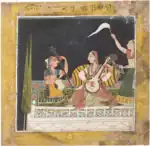 Mughal painting from 1630 by Govardhan with a musician playing a seni rebab. | |
| Classification | |
|---|---|
| Related instruments | |
| Arbajo, Dotara, Dranyen, Kabuli rebab Pamiri rubab, Sarod, Tungna, Dutar, Tanbur | |
The Seni rebab (Hindustani: सेनी रबाब (Devanagari), سینی رباب (Nastaleeq), Punjabi: ਸੇਨੀ ਰੱਬਾਬ), also known as the Seniya rabab (Hindustani: सेनिया रबाब (Devanagari), سنیا رباب (Nastaleeq)) is a plucked string instrument used in northern India that is said to have been developed by, and to have taken its name from, the notable musician Tansen in the time of the emperor Akbar the Great. It has "a large hook at the back of its head, making it easier for a musician to sling it over the shoulder and play it even while walking."[1] It has been used in Hindustani classical music and religiously, in Sikh music.[1][2][3] The rebab influenced the development of the sarod, another Indian musical instrument.[2]
Three types of Sikh musician - rababis, ragis and dhadhis - flourished during the period of the Sikh gurus.
History
As the Dekhani rabāb, the instrument was listed as a native instrument of Central India by Mughal chronicler Abu'l Fazl. It was played by different castes, from the high Brahmins leading religious songs to "low-caste entertainers."[4]
The instrument was associated with the Seniya family, of whom Tansen was one.[4] Tansen has been credited with "popularizing" the rabāb. The name seni rabāb may be an Indian adaptation from a Persian designation of the instrument; "Sen-e-rabab" is supposed to mean rebab of [Tan] Sen.[5]
Religion
Guru Nanak started the Sikh rababi tradition by engaging Bhai Mardana as his accompanist. The Muslim singers known as Mirasis were "rababis", because they played on the rabab or rebec. Some notable rababis after Mardana were his son Shahjada, Balwand and Satta, Babak, son of Satta, Chatra, son of Babak, and Saddu and Baddu. Rababis used to perform kirtan regularly at Amritsar before the partition of India in 1947, after which many of the rababis migrated to Pakistan. The Sikh rabab was traditionally a local Punjabi variant known as the 'Firandia' rabab (Punjabi: ਫਿਰੰਦੀਆ ਰਬਾਬ Phiradī'ā rabāba),[6][7][8][9] however Baldeep Singh, an expert in the Sikh musical tradition, challenges this narrative.[10][11]
The last of the line of rababis was Bhai Chand. During the 20th century CE the instrument's use in Sikh kirtan was eclipsed by the harmonium but it has been revived.[12]
 Women playing veena and seni rabab,1680-1700.
Women playing veena and seni rabab,1680-1700.
References
- 1 2 "The roar of Afghan's 'lion of instruments'". Deccan Herald. 10 April 2016. Retrieved 16 August 2021.
- 1 2 Kasliwal, Suneera. "Rabab". India Instruments. Retrieved 10 September 2021.
- ↑ Nair, Jyoti (2020-02-27). "Gurbani: Flavour of Sikh devotion". The Hindu. ISSN 0971-751X. Retrieved 2020-03-01.
Rabab is associated with the Sikh sacred music and can be traced to Guru Nanak Devji's bhajans, almost 500 years ago
- 1 2 Sadie, Stanley, ed. (1984). "Rabab, #4". The New Grove Dictionary of Musical Instruments. pp. 181–182. Volume 3.
- ↑ David Courtney. "Seni Rabāb". chandrakantha.com.
- ↑ "Rabab". Sikh Musical Heritage - The Untold Story. Retrieved 2022-08-18.
- ↑ "Raj Academy | Rabab". Raj Academy. Retrieved 2022-08-18.
- ↑ "Rabab". SIKH SAAJ. Retrieved 2022-08-18.
- ↑ "Sikh Instruments-The Rabab". Oxford Sikhs. Retrieved 2022-08-18.
- ↑ Bharat Khanna (Nov 1, 2019). "Punjabi varsity's Firandia rabab helps revival of string instrument | Ludhiana News - Times of India". The Times of India. Retrieved 2022-08-18.
- ↑ Singh, Baldeep (2012-06-27). "Rabab goes shopping…". The Anād Foundation. Retrieved 2022-08-18.
- ↑ PTI (2022-05-25). "SGPC to revive 'gurbani kirtan' with string instruments in Golden Temple". ThePrint. Retrieved 2022-08-29.